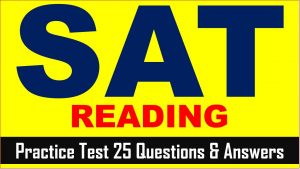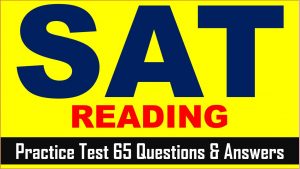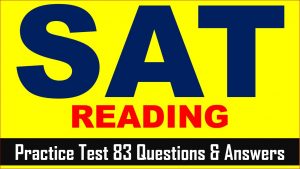SAT (Scholastic Assessment Test) is a standard test, used for taking admission to undergraduate programs of universities or colleges of the United States. SAT is developed and published by the College Board, an organization in the United States, administered by the Educational Testing Service. In this article of AKVTutorials, you will get Kaplan Online SAT Prep Course Book Review | Practice Test 13 AMBiPi.
Kaplan Online SAT Prep Course Book Review
Are you SAT Exam 2024 aspirant and want to start your preparation from book SAT Prep Plus 2024 Kaplan?
If yes, then first you must to know about Kaplan Book.
Check Price On Amazon
How to start your SAT preparation from Kaplan and how to read this book.
Let’s start to know full details of Kaplan SAT Guidance Book.
Kaplan is a publishing company, in New York, that clearly declared that SAT is a registered and owned by College Board and this Kaplan SAT Book is not endorsed by College Board.
In this book, the authors and reviewers share their guidance of clearing SAT exam 2024.
The authors and reviewer of Kaplan SAT book are Micheal Cook, Christopher Cosci, Boris Dvorkin, John Evans, Jack Hayes, Rebecca Knauer, Jo L’Abbate, Bird Marathe, Karen McCulloch, Melissa McLaughlin, Gail Rivers, Anne Marie Salloum, Jason Selzer, Gordon Spector, Carline Sykes, Bob Verini, MFA, Bonnie Wang and Ethan Weber.
These authors provide accurate information in regard to the subject matter covered as of its publication data, with the understanding that knowledge and best practice constantly evolve.
According to these authors of Kaplan SAT preparation book, any aspirant can get a great SAT score from active engagement of this book. Kaplan provides a direction, focus your SAT preparation and teaches you specific skills that is required to crack SAT exam 2024.
In this Kaplan book for SAT, practice tests are just like actual SAT exam. By practicing these tests, you will prepare yourself for the actual test day experience.
Every chapter in Kaplan start with “How Much Do You Know”, where a typical question is asked related to SAT exam syllabus and at the end of the chapters a practice set is given and hence you check “How Much Have You Learned”.
Apart from SAT practice test, this book has
- How to Maximize Your Score
- Where and When to Take SAT Exam
- Triaging SAT Test
- Elimination
- Strategic Guessing
Kaplan SAT Prep Book Table of Contents
Part 1: The SAT and You
- Chapter 1: Inside the SAT
Part 2: SAT Math
- Chapter 2: Prerequisite Skills and Calculator Use
- Chapter 3: The Method for SAT Math Questions
Part 2A: The Heart of Algebra
- Chapter 4: Linear Equations and Graphs
- Chapter 5: System of Linear Equation
- Chapter 6: Inequalities
Part 2B: Data Analysis
- Chapter 7: Ratios, Proportions, and Percent
- Chapter 8: Tables, Statistics and Probability
- Chapter 9: Scatterplot
Part 2C: Passport to Advance Math
- Chapter 10: Functions
- Chapter 11: Exponents, Radicals, Polynomials and Rational Expressions
- Chapter 12: Quadratics
Part 2D: Other Topics in Math
- Chapter 13: Geometry
- Chapter 14: Trigonometry
- Chapter 15: Imaginary Numbers
- Chapter 16: SAT Math: Timing and Section Management Strategies
Part 3: SAT Reading
- Chapter 17: The Method for SAT Reading Questions
- Chapter 18: SAT Reading Passage Strategies
- Chapter 19: SAT Reading Questions Types
- Chapter 20: Answering SAT Reading Questions
- Chapter 21: Paired Passage and Primary Source Passages
- Chapter 22: Literature Passages
- Chapter 23: SAT Reading: Timing and Section Management Strategies
Part 4: SAT Writing and Language
- Chapter 24: The Method for SAT Writing and Language Questions
- Chapter 25: Spotting and Fixing Errors: Sentence Structure, Punctuation, and Agreement
- Chapter 26: Spotting and Fixing Errors: Organization, Development and Graphs
- Chapter 27: SAT Writing and Language: Timing and Section Management Strategies
Part 5: SAT Essay
- Chapter 28: The Method for SAT Essay Questions
Part 6: Countdown to Test Day
- Chapter 29: Countdown to Test Day
Part 7: Practice Tests
Check Price On Amazon
According to Kaplan SAT Math section, the SAT Math sections are distributed as below:
In Heart of Algebra of Kaplan SAT Book, Analyzing and solving equations and systems of equations; creating expressions, equations, and inequalities to represent relationships between quantities and to solve problems; rearranging and interpreting formulas.
In Problems Solving and Data Analysis of Kaplan SAT Book, Creating and analyzing relationships using ratios, proportions, percentages, and units; describing relationships shown graphically; summarizing qualitative and quantitative data.
In Passport to Advance Math of Kaplan SAT Book, using function notation; creating, analyzing, and solving quadratic and higher-order equations; manipulating polynomials to solve problems.
In Additional Topics in Math of Kaplan SAT Book, making area and volume calculations in context; investigating lines, angles, triangles, and circles using theorems; working with trigonometric functions and complex numbers.
According to Kaplan SAT Reading section, the SAT Reading sections will focus on your comprehension and reasoning skills when you are presented with challenging extended prose passages taken from a variety of content areas. Passages will draw from U.S. and World Literature, History/Social Studies, and Science. One set of History/Social Studies or Science passages will be paired. History/Social Studies and Science passages can also be accompanied by graphical representations of data such as charts, graphs, tables, and so on.
Now, let practice SAT Reading Passage and answer the questions
SAT Reading Practice Passage
This passage is adapted from Thor Hanson, Feathers. ©2011 by Thor Hanson. Scientists have long debated how the ancestors of birds evolved the ability to fly. The ground-up theory assumes they were fleet-footed ground dwellers that captured prey by leaping and flapping their upper limbs. The tree-down theory assumes they were tree climbers that leaped and glided among branches.
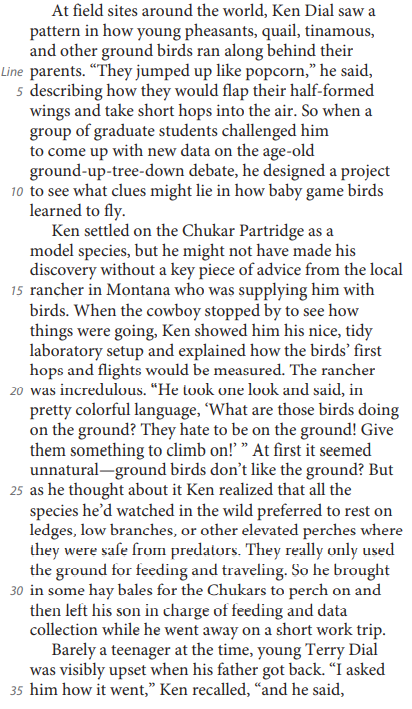
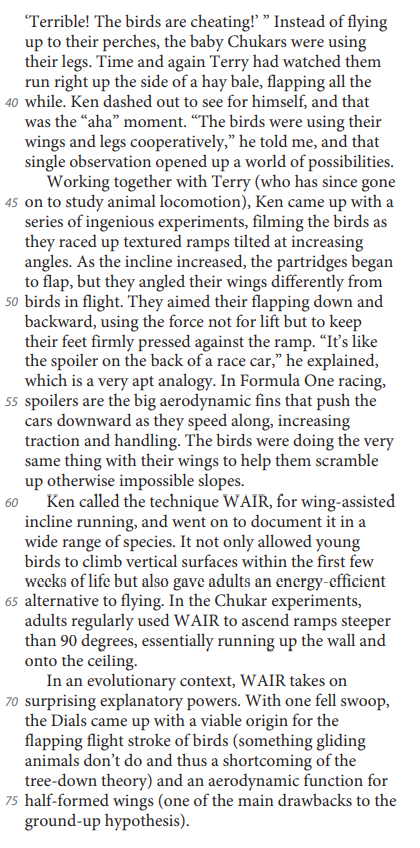
SAT Reading Comprehension Practice Test Questions
SAT Practice Test 13 Question No 1
Which choice best reflects the overall sequence of events in the passage?
Option A: An experiment is proposed but proves unworkable; a less ambitious experiment is attempted, and it yields data that give rise to a new set of questions.
Option B: A discovery leads to a reconsideration of a theory; a classic study is adapted, and the results are summarized.
Option C: An anomaly is observed and simulated experimentally; the results are compared with previous findings and a novel hypothesis is proposed.
Option D: An unexpected finding arises during the early phase of a study; the study is modified in response to this finding, and the results are interpreted and evaluated.
SAT Practice Test 13 Answer No 1
Show/Hide Answer
Option D :
The author explains that Ken Dial created an experiment to study the evolution of flight by observing how baby Chukars learn to fly. During the experiment, Dial noticed the unusual way Chukars use their “‘wings and legs cooperatively’” to scale hay bales (lines 38-43), and he created “a series of ingenious experiments” (line 46) to study this observation. After his additional experiments, Dial determined that these baby birds angle “their wings differently from birds in flight” (lines 49-50).
Choices A, B, and C are incorrect because they do not accurately reflect the sequence of events in the passage.
SAT Practice Test 13 Question No 2
As used in line 7, “challenged” most nearly means
Option A: dared.
Option B: required.
Option C: disputed with.
Option D: competed with.
SAT Practice Test 13 Answer No 2
Show/Hide Answer
Option A :
In lines 6-9, the author explains that Dial was “challenged,” or dared, by graduate students to develop “new data” on a long-standing scientific debate (the “ground-up-tree-down” theory).
Choices B, C, and D are incorrect because in this context “challenged” does not mean required, disputed with, or competed with.
SAT Practice Test 13 Question No 3
Which statement best captures Ken Dial’s central assumption in setting up his research?
Option A: The acquisition of flight in young birds sheds light on the acquisition of flight in their evolutionary ancestors.
Option B: The tendency of certain young birds to jump erratically is a somewhat recent evolved behavior.
Option C: Young birds in a controlled research setting are less likely than birds in the wild to require perches when at rest.
Option D: Ground-dwelling and tree-climbing predecessors to birds evolved in parallel.
SAT Practice Test 13 Answer No 3
Show/Hide Answer
Option A :
The author explains that Dial created his initial experiment to try and create “new data on the age-old ground-up-tree-down debate,” and that he looked for “clues” in “how baby game birds learned to fly” (lines 8-11). The note at the beginning of the passage explains the “age-old ground-up-tree down debate” and offers two different theories on how birds evolved to fly. Finally, the last paragraph of the passage discusses WAIR in an evolutionary context.
Choices B, C, and D are incorrect because they do not identify Dial’s central assumption in setting up his research.
SAT Practice Test 13 Question No 4
Which choice provides the best evidence for the answer to the previous question?
Option A: Lines 1-4 (“At field… parents”)
Option B: Lines 6-11 (“So when… fly”)
Option C: Lines 16-19 (“When… measured”)
Option D: Lines 23-24 (“At first…the ground”)
SAT Practice Test 13 Answer No 4
Show/Hide Answer
Option B :
In lines 6-11, the author provides evidence that Dial’s central assumption in setting up his research is that the acquisition of flight in young birds is linked to the acquisition of flight in their ancestors. The author notes that Dial created a project to “come up with new data on the age-old ground-up-tree-down debate.”
Choices A, C, and D do not provide the best evidence that Dial’s central assumption in setting up his research is that the acquisition of flight in young birds is linked to the acquisition of flight in their ancestors. Choices A, C, and D are incorrect because they focus on Dial’s experiment and his observations on ground birds.
SAT Practice Test 13 Question No 5
In the second paragraph (lines 12-32), the incident involving the local rancher mainly serves to
Option A: reveal Ken Dial’s motivation for undertaking his project.
Option B: underscore certain differences between laboratory and field research.
Option C: show how an unanticipated piece of information influenced Ken Dial’s research.
Option D: introduce a key contributor to the tree-down theory.
SAT Practice Test 13 Answer No 5
Show/Hide Answer
Option C :
When a rancher observed Dial’s laboratory setup, he was “incredulous” that the Chukars were living on the ground, and he advised Dial to give the birds “something to climb on” (lines 16-23). This “key piece of advice” (line 14) led Dial to add hay bales to his laboratory. Dial later noticed that the Chukars were using their legs and wings to scale the hay bales, and this observation became the focal point of his research.
Choices A, B, and D are incorrect because the incident with the local rancher did not serve to reveal Dial’s motivation for creating the project, emphasize differences in laboratory and field research, or introduce a contributor to a scientific theory.
SAT Practice Test 13 Question No 6
After Ken Dial had his “‘aha’ moment” (line 41), he
Option A: tried to train the birds to fly to their perches.
Option B: studied videos to determine why the birds no longer hopped.
Option C: observed how the birds dealt with gradually steeper inclines.
Option D: consulted with other researchers who had studied Chukar Partridges.
SAT Practice Test 13 Answer No 6
Show/Hide Answer
Option C :
The author explains that Dial’s “aha moment” came when he determined the Chukars used “their legs and wings cooperatively” to scale the hay bales (lines 40-42). Dial then created additional experiments to study how the birds dealt with gradually steeper inclines: “[he filmed] the birds as they raced up textured ramps tilted at increasing angles” (lines 46-48).
Choices A, B, and D are incorrect because Dial’s “aha moment” was not followed by Dial teaching the birds to fly, studying videos to find out why the birds no longer hopped or consulting with other researchers.
SAT Practice Test 13 Question No 7
The passage identifies which of the following as a factor that facilitated the baby Chukars’ traction on steep ramps?
Option A: The speed with which they climbed
Option B: The position of their flapping wings
Option C: The alternation of wing and foot movement
Option D: Their continual hopping motions
SAT Practice Test 13 Answer No 7
Show/Hide Answer
Option B :
Dial observed that as the Chukars raced up steep ramps, they “began to flap” and “aimed their flapping down and backward, using the force . . . to keep their feet firmly pressed against the ramp” (lines 49-53). Dial determined that the position of their flapping wings facilitated the baby Chukars’ traction on the steep ramps.
Choices A, C, and D are incorrect because the passage does not indicate that the Chukars’ speed, alternation of wing and foot movement, or continual hopping motions facilitated their traction on steep ramps.
SAT Practice Test 13 Question No 8
As used in line 61, “document” most nearly means
Option A: portray.
Option B: record.
Option C: publish.
Option D: process.
SAT Practice Test 13 Answer No 8
Show/Hide Answer
Option B :
In lines 61-63, the author explains that Dial named his scientific finding “WAIR, for wing-assisted incline running, and went on to document it in a wide range of species.” In this context, Dial “documented,” or recorded, the existence of WAIR in numerous bird species.
Choices A, C, and D are incorrect because in this context, “document” does not mean to portray, publish, or process.
SAT Practice Test 13 Question No 9
What can reasonably be inferred about gliding animals from the passage?
Option A: Their young tend to hop along beside their parents instead of flying beside them.
Option B: Their method of locomotion is similar to that of ground birds.
Option C: They use the ground for feeding more often than for perching.
Option D: They do not use a flapping stroke to aid in climbing slopes.
SAT Practice Test 13 Answer No 9
Show/Hide Answer
Option D :
In lines 70-74, the author explains that gliding animals do not use a “flapping flight stroke,” or WAIR, wing-assisted incline running. Since Chukars, a ground bird, use WAIR to help scale steep inclines, it can be reasonably inferred that gliding animals do not use WAIR to aid in climbing slopes.
Choices A, B, and C are incorrect because the passage does not include information on gliding animals’ offspring, their method of locomotion, or their feeding habits.
SAT Practice Test 13 Question No 10
Which choice provides the best evidence for the answer to the previous question?
Option A: Lines 4-6 (“They jumped… air”)
Option B: Lines 28-29 (“They really… traveling”)
Option C: Lines 57-59 (“The birds… slopes”)
Option D: Lines 72-74 (“something… theory”)
SAT Practice Test 13 Answer No 10
Show/Hide Answer
Option D :
In lines 73-75, the author provides evidence that “the flapping flight stroke” is “something gliding animals don’t do.
Choices A, B, and C do not provide the best evidence that gliding animals do not use a flapping stroke to aid in climbing slopes. These choices do not contain information about gliding animals.




